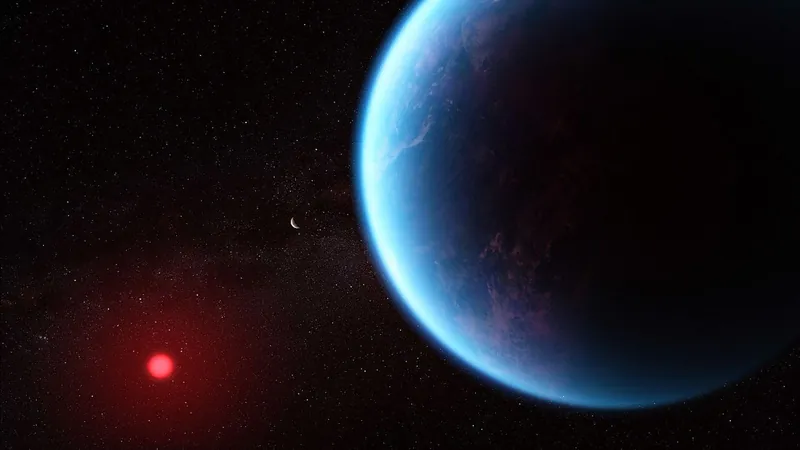
Unveiling Alien Atmospheres: James Webb's Groundbreaking Discovery
2025-04-24
Author: Charlotte
A Cosmic Breakthrough: K2-18b's Atmosphere Revealed
In a stunning revelation, the James Webb Space Telescope (JWST) has delivered the most intricate analysis yet of the atmosphere surrounding an exoplanet beyond our Solar System. This study brings forth intriguing evidence of two chemical compounds, dimethyl sulfide (DMS) and dimethyl disulfide (DMDS), on the distant world known as K2-18b. While these compounds are typically associated with biological processes on Earth, they can also originate from non-biological sources in the universe.
Far-Flung Worlds Awaiting Discovery
K2-18b orbits a red dwarf star—a type of star that's cooler and smaller than our Sun—situated around 120 light-years away. This exoplanet is among numerous celestial bodies currently under investigation by astronomers utilizing the JWST's advanced capabilities.
The Team Behind the Discovery
This groundbreaking research was spearheaded by Nikku Madhusudhan, a respected astrophysics professor at the University of Cambridge. Collaborating with a team from the UK and the US, Madhusudhan's efforts highlighted the extensive support of thousands of scientists and engineers involved in operating the JWST.
Tantalizing Yet Cautious Findings
Media buzz has notably gravitated towards the possible implications for extraterrestrial life due to the sulfur compounds detected. However, while the data suggests a 99.7 percent likelihood for the existence of both DMS and DMDS—a "3 sigma significance"—it's important to note that such certainty does not eliminate alternative explanations. The study itself emphasizes the necessity of further observations to solidify these findings.
The Search for Life Beyond Earth
Despite initial sensational headlines, the findings do not confirm alien life forms. Even if DMS and DMDS are validated, extensive research will be needed to eliminate other potential sources of these compounds. The ongoing exploration of K2-18b's atmospheric chemistry remains a critical focus.
Building on Past Discoveries
The latest analysis builds upon a decade of observations from the Kepler and Hubble Space Telescopes. Initially identified by Kepler in 2015, K2-18b's periodic dimming suggested the presence of a large body transiting its star. Subsequent research has shown that this exoplanet is about 8.6 times more massive than Earth and boasts a diameter approximately 2.6 times greater.
Future of K2-18b Research
Plans for follow-up studies raised questions about the chemical makeup of K2-18b’s atmosphere, presenting several hypotheses regarding its nature—whether a small gas giant, a rocky planet with a thin hydrogen atmosphere, or a massive ocean world. Unfortunately, prior studies from Hubble did not provide conclusive results.
JWST's Enhanced Capabilities
Using JWST's superior resolution, Madhusudhan's team uncovered stronger evidence for methane versus water vapor in K2-18b’s atmosphere and also detected carbon dioxide. Notably, while water vapor hasn’t been ruled out, it appears absent from the atmospheric layers JWST can examine.
Biosignatures and New Frontiers in Chemistry
The presence of DMS and DMDS carries significant implications for the search for life, as these chemicals are typically products of biological activity on Earth. However, their existence elsewhere in the universe—like giant molecular clouds—means further study is essential.
Hycean Worlds: Theoretical Giants Awaiting Confirmation
Current models of hycean worlds, theorized to be larger than Earth with hydrogen-rich atmospheres, showcase a broad potential for liquid water. However, even categorizing K2-18b as a hycean world isn’t confirmed yet, primarily due to the challenges in studying atmospheres of planets orbiting red dwarf stars.
Advancements Amidst Challenges
Detecting the unique molecular signatures from these alien atmospheres relies heavily on analyzing the light spectra that transmits through various atmospheric layers. The JWST's capability to discern these signals amidst the chaotic emissions from red dwarf stars signifies a monumental engineering achievement.
A Call for Continued Scientific Pursuit
The success of JWST reaffirms the validity of decades of scientific investment—an adventure juxtaposed against contemporary anti-science sentiments. As astronomical research progresses, the hope remains that the quest for knowledge will not be hindered by political agendas. The pursuit of discovery continues driven by a global community dedicated to advancing human understanding of the universe.









 Brasil (PT)
Brasil (PT)
 Canada (EN)
Canada (EN)
 Chile (ES)
Chile (ES)
 Česko (CS)
Česko (CS)
 대한민국 (KO)
대한민국 (KO)
 España (ES)
España (ES)
 France (FR)
France (FR)
 Hong Kong (EN)
Hong Kong (EN)
 Italia (IT)
Italia (IT)
 日本 (JA)
日本 (JA)
 Magyarország (HU)
Magyarország (HU)
 Norge (NO)
Norge (NO)
 Polska (PL)
Polska (PL)
 Schweiz (DE)
Schweiz (DE)
 Singapore (EN)
Singapore (EN)
 Sverige (SV)
Sverige (SV)
 Suomi (FI)
Suomi (FI)
 Türkiye (TR)
Türkiye (TR)
 الإمارات العربية المتحدة (AR)
الإمارات العربية المتحدة (AR)